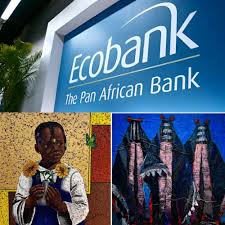Ecobank Nigeria has reaffirmed its commitment to supporting the country’s creative arts industry as it launched a major exhibition in Lagos showcasing the works of legendary Nigerian artists. The exhibition, titled “Enduring Legacies: A Collector’s Tribute to Masters,” opened on Friday, September 5, and will run until Sunday, September 21, 2025, at EPAC Studios in Lagos.
The event is dedicated to honouring iconic names in Nigerian visual arts, including Bruce Onobrakpeya, Twins Seven Seven, and Kolade Oshinowo. Other celebrated artists whose works are on display include Muraina Oyelami, Moses Unokwah, Jimoh Buraimoh, Rufus Ogundele, Oyerinde Olotu, Lamidi Fakeye, Ablade Glover, Alex Nwokolo, Tony Enebeli, Sam Ovraiti, David Dale, Ben Osawe, Rom Isichei, Tola Wewe, and Ini Brown.
The Managing Director of Ecobank Nigeria, Mr. Bolaji Lawal, emphasized that the bank’s involvement in the exhibition reflects its broader role in preserving and promoting African cultural heritage. Speaking through Omoboye Odu, the Head of SMEs, Partnerships, and Collaborations at Ecobank, he explained that the initiative aligns with the bank’s corporate social responsibility focus on cultural and economic development.
“Our support underscores Ecobank’s role, not only as a financial institution, but also as a patron of African creativity and cultural heritage,” Odu said. “This initiative aligns with our CSR focus on economic and cultural development and complements our boldness in empowering creative entrepreneurs. For those familiar with Ecobank, we’ve been projecting Nigerian creatives through events such as Adire Lagos, the +234 Art Fair, and Òja Ògé pop-ups. This exhibition is a continuation of that effort.”
He noted that showcasing Nigerian creativity to the world goes beyond finance, adding that the arts can reshape global perceptions about the country. “It reminds us that Nigeria’s narrative can continue to change, not just in naira and kobo, but in the beauty that we can bring to the rest of the world to see,” he added.
The exhibition’s curator, Adekepemi Aderemi, described the project as a deep dive into Nigeria’s rich artistic tradition. She revealed that the selection process involved spending days reviewing an extensive private collection of artworks, calling the experience one of the highlights of her career.
“I went into his private collection and spent days and days sifting through the work. It was a beautiful experience for me, genuinely a career highlight,” Aderemi explained. “Some of these are artists you’ve heard of but works you’ve not seen in real life. Some are long dead. The pieces not only demonstrate technical brilliance but also narrate the evolution of modern and contemporary Nigerian art. I want visitors to feel reverence, pride, and connection to the past.”
The collector behind the exhibition, Andrew Ine, founder of KrabHouse Gallery, spoke passionately about his motivation. Over several decades, Ine has amassed more than 30,000 works of art, many of which are now being made available for public viewing.
“Sometimes I get to my gallery, I get emotional, and I cry because I never, in my entire life, believed I would acquire up to 30,000 artworks,” Ine said. “Every day, I speak to art. They speak to me. They take me backward; they take me forward. They make me look at generations in between. It’s not about money; it’s about creating a legacy. People have different relationships with art; it speaks differently to everyone. For me, this is passion, not profit.”
He stressed that beyond commerce, art remains an important vessel for memory, identity, and heritage. “Imagine these works being in your home; imagine them somewhere that you can say, ‘I own this.’ The takeaway will be that visitors will interact with the works, be happy, be inspired, and see hope for Nigeria’s young artists. I believe even the departed masters, wherever they are, are smiling at this moment,” Ine said.
The exhibition is expected to draw artists, collectors, scholars, and cultural enthusiasts from across Nigeria and beyond. Organisers say it offers a rare opportunity for Nigerians to connect with their heritage and for younger artists to find inspiration in the works of past masters.
